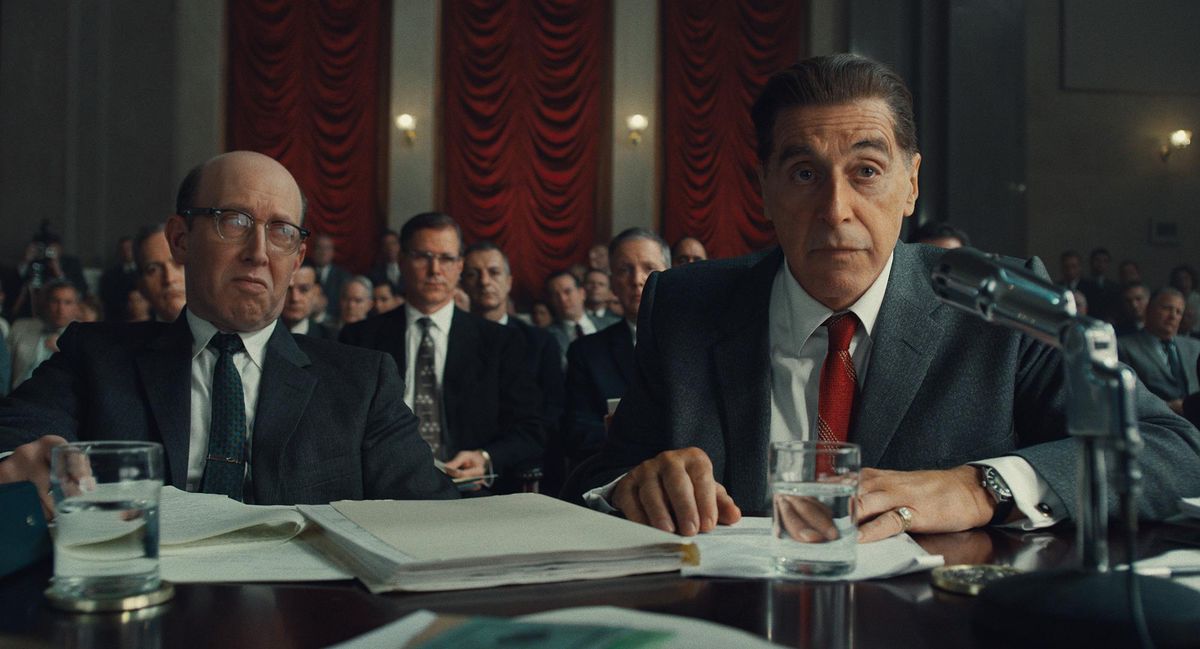Scorsese’s ‘The Irishman’ dismantles myths filmmaker helped create in movies like ‘Goodfellas’

“The Irishman,” Martin Scorsese’s long-gestating gangland epic, starts off with a bittersweet inside joke: A long tracking shot – one of the director’s bravura signatures – that threads the audience, not through the labyrinthine hallways and kitchens of the Copacabana, but an old folks’ home, where the film’s protagonist, Frank Sheeran, can be found ruminating on a life not well-lived as much as jam-packed with incident, incitement, fierce loyalties and breathtaking betrayals.
As portrayed by Robert De Niro, Sheeran is something of a cipher in “The Irishman,” which spans several decades as he relates how he came to be a hitman for the Philadelphia mob, a confidante of Teamsters leader Jimmy Hoffa and, ultimately, the guy who put Hoffa down for good in 1975 (to this day, his disappearance is considered an unsolved mystery).
This sprawling, colorful, elegiac and often wryly amusing saga – adapted from Charles Brandt’s book ”I Heard You Paint Houses“ – advances an intriguingly convincing chronicle of how criminal and political forces converged to have Hoffa whacked by one of his closest associates.
As one of Scorsese’s most ambitious films in recent memory, it also manages to revisit the tribal rites and rituals that have fascinated him throughout a wildly productive 60-year career, framing them within a wider social history as animated by corruption and conspiracy as by the loftiest American ideals.
In other words, for Scorsese fans eager to savor the director’s most personal themes and signature cinematic gestures, “The Irishman” is a feast for the ages, a groaning board of exquisitely photographed scenes, iconic performances and tender nods toward old age that leave viewers in a mood more wistful than keyed-up.
(For those less enamored of the filmmaker’s vulgarity-spewing antiheroes and crime-world tropes, ”The Irishman“ will often feel needlessly repetitive, sludgy and self-indulgent.) Scorsese doesn’t shy away from the visceral ruthlessness and male codes of honor and disgrace that have always attracted him. In “The Irishman” they play out slowly, sadly, the better to consider the emptiness at their core.
Spanning 1949 to 2000, “The Irishman” recounts how Sheeran – a World War II veteran who drives a meat truck for a living – meets Russell Bufalino (Joe Pesci), a soft-spoken Mafia don who is part of a syndicate that controls Philadelphia, Pittsburgh and Detroit. After proving his bona fides, Sheeran eventually meets Hoffa (Al Pacino), with whom he forms an indelible bond, becoming the union boss’s steadfast fixer, enforcer and family friend.
Just how Sheeran went from Hoffa’s trusted confidant to murderer forms the emotional arc of “The Irishman,” which was written for the screen by Steven Zaillian. And even if the answer still isn’t entirely clear by the end of the film’s prodigious 3 1/2-hour running time, Scorsese gives audiences plenty of atmospheric set pieces and larger-than-life characters to keep them from feeling deprived.
De Niro and Pesci, who haven’t worked together under Scorsese since 1995’s “Casino,” get back into harness with each other with the ease of the pros that they are: Pesci’s relatively mild-mannered Bufalino is a particularly surprising and welcome departure from the hair-trigger histrionics of the characters for which he’s best known.
But it’s when Pacino arrives on the scene as Hoffa that “The Irishman” truly levitates, the actor making his Scorsese picture debut with a performance that is at once bombastic and subtle, obnoxious and curiously sympathetic. Throughout the film, Sheeran’s daughter Peggy looks askance at Bufalino while trusting Hoffa implicitly (maybe because he loves ice cream as much as she does).
Played by Anna Paquin as a young woman, Peggy becomes perhaps the most maddeningly paradoxical figure in “The Irishman,” largely silenced by the filmmakers (she literally speaks only one or two lines), her increasingly appalled glares at Sheeran serving as stand-ins for conscience in his otherwise amoral, transactional world.
One of the reasons “The Irishman” has taken so long to get to the screen was the tricky business of de-aging the lead actors for its earliest scenes; here, the process is barely noticeable thanks not only to the sophistication of computer technology but Rodrigo Prieto’s exquisite cinematography, which suggests several different eras through the use of changing palettes (the film toggles between the ’50s, ’60s, ’70s and early aughts).
Although “The Irishman” is full of familiar Scorsese motifs – one-on-one encounters dripping with subtextual dread, nightclub outings with “the wives” and a crooner onstage, those gorgeous dolly shots – here they’re recapitulated with a more mournful, contemplative tone.
Indeed, “The Irishman” is so full of Scorsese’s most-beloved rep players and repeated tropes that it’s difficult not to compare it to such predecessors as “Mean Streets,” “Raging Bull” and especially “Goodfellas.” (The equivalent scene to the Lufthansa heist here is a wonderfully piquant account of the Bay of Pigs operation.)
This film is populated by the same thugs, bullies, mooks and mugs – not to mention a Kennedy or two – but by now it’s clear that the filmmaker might be willing to entertain the possibility that they’re not as inherently interesting as Hollywood’s infatuation with alluring outlaws might suggest.
Of course Scorsese himself has been a chief propagator of those myths, which he dismantles with as much craftsmanship and feeling in “The Irishman” as he did while building them up so seductively in his earlier films.
With its obsession with process and how-it-all-went-down chronology, “The Irishman“ is tiresome, at times even dull in its pointless arguments and profane ego trips. But that leaves viewers confronting how movies – especially Scorsese’s – have shaped our most disquieting desires.
“The Irishman” isn’t a soaring achievement: It’s a deliberate, thoughtful and somewhat muted one. No matter where that traveling camera goes, its subverts our expectations at every turn. Which can sometimes feel like a drag, but also exactly right.